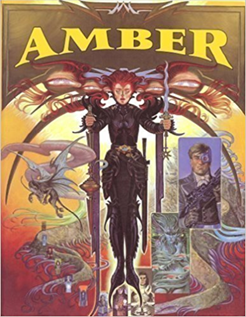 When I was at university – so many years ago – a game was released based on the works of Roger Zelazny. Called Amber Diceless Roleplaying, it cast the player characters as the sons and daughters of an immortal, immensely powerful family, who were basically gods.
When I was at university – so many years ago – a game was released based on the works of Roger Zelazny. Called Amber Diceless Roleplaying, it cast the player characters as the sons and daughters of an immortal, immensely powerful family, who were basically gods.
The interesting thing about the game was that the characters didn’t like each other that much. The game was designed so that typical play wasn’t the characters dealing with a threat invented by the Dungeon Master, they were instead dealing with the plans of the other player characters! The purest expression of this came during the game known as a Throne War. In that, the characters were vying for the throne of Amber. Whoever ended up on the throne was the winner of the game.
You know how there’s said to not be a “winner” in most RPGs? Not the case in a Throne War. There was definitely a winner in that game!
An auction at the beginning of the campaign determined how good the players were in relationship to each other in four basic statistics: Warfare, Endurance, Strength and Psyche. The initial bidding helped set up the rivalries between the characters. You wanted to be the best spellcaster? Well, that person over there beat you! And, because you were rarely working together, that meant something. It meant that if you wanted to beat them, you needed to be tricky. Or have allies. And there came the fun of the game.
Amber was a great game to role-play in. And it helped promote role-playing because the best allies for your character were the other characters. So, you had to talk to them. And because your goals didn’t all align, you had this wonderful interaction where the players would discuss something, all looking to gain advantage for their character, while not letting any of the others get too far ahead.
Many of the games I ran I’d just adjudicate competitions between player characters (they might fight each other or engage in a mind duel), while occasionally throwing in an external threat to distract them (or some of them) from their “main” goal. Did they work together to defeat it, or did some take the opportunity to gain an advantage?
This level of rivalry doesn’t work with most RPGs, but it does point to a way to promote better role-playing in your games: You need to give the characters reasons to interact.
The fact is that role-playing between the player and the Dungeon Master is somewhat limited. It often devolves to one-on-one, or at least has a very limited participation rate. After all, when you do a regular negotiation, it’s rarely six people on one side talking at once to another! It will primarily be one or two people talking, with others contributing a much lesser amount. And the Dungeon Master also needs to concentrate on other matters. So, the more role-playing the characters do with each other, the better the overall role-playing experience will be.
This isn’t to say that the NPCs the DM controls don’t have a valuable role to play in interactions. The trick here is to provide a character that is interesting to interact with… and can be interacted with in separate ways by different PCs. At the D&D table, you don’t want party members fighting each other, but if their goals are slightly divergent, and the NPC could figure in achieving one but not all? That gives rise to an interesting situation.
Another thing Amber taught me was about player-driven scenarios (of which we tend to refer to in D&D as sandboxes). Namely, they only work if the players are good at generating plots themselves. For players who are reactive in play and prefer to go on missions designed by the DM, they’re not so good. However, this isn’t a problem if you have a couple of players who are proactive and go seeking to fulfil their goals; the other players will follow them!
Part of this comes from a lack of knowledge about the setting. I find it very difficult to generate my own goals and take my player character in interesting directions if I’m ignorant of what’s in the game world and how it will be run. It’s no good creating a character that is the Scourge of Undead when you never encounter an undead creature! It’s in character creation that the DM needs to work with the players to explain the basic set-up of the campaign. It very much helps players if the DM can suggest some potential goals for characters, giving a view as to what directions the campaign may go. Of course, these things can be changed and adapted when the campaign starts, but at least have a starting point.
It’ll make things much easier for everyone!
